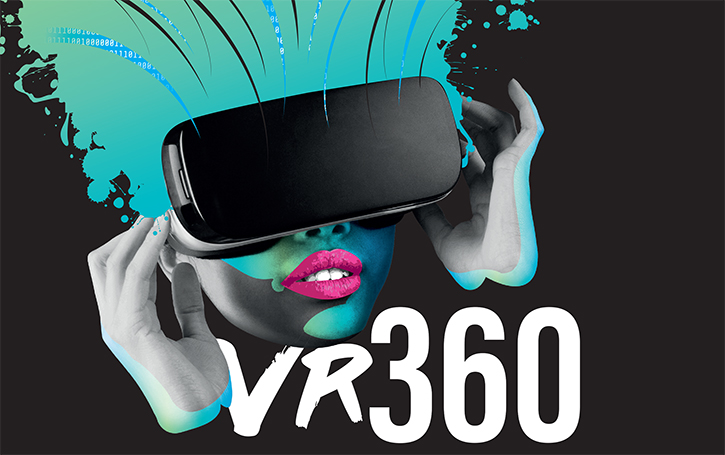Round Table: A 360 view of VR

Posted on Apr 2, 2018 by FEED Staff
Our FEED round table takes a 360º look at the state of VR. The one thing our five guests do agree on: VR tech is just getting started.
This month’s FEED Round table guests are:

Maria Korolov, WiVR,
Maria Korolov has been covering emerging technology and emerging markets for 20 years. She is also founder and president of Women in Virtual Reality, an organisation dedicated to increasing the visibility of women in the VR field.

Muki Kulhan Muki International
Muki Kulhan is an executive digital producer who has been instrumental in bringing VR and immersive experience to major media and entertainment brands, including BBC, ITV, MTV, Jamiroquai and the Jamie Oliver Foundation.

Tanya Laird Digital Jam
Tanya Laird is CEO and founder of digital entertainment consultancy Digital Jam. The company’s Digital Jam Sessions are a series of podcast round tables which bring together disparate arms of the creative and tech industries to brainstorm, problem-solve and vision the future.

Fabrice Lorenceau LiveLike
Fabrice Lorenceau is co-founder and head of productions of LiveLike, a pioneering virtual reality and mixed reality studio which has produced live immersive content for major sports events, including the French Open, NFL Super Bowl and UEFA Champions League.

Lucas Wilson Supersphere
Lucas Wilson is founder and executive producer of VR creative services company Supersphere. Wilson has a long history in the development of next-gen capture and display and was on the team of James Cameron’s 3D start-up Cameron-Pace Group.
FEED: Ask five people what virtual reality is and you’ll get five different answers. How do you define ‘VR’?
Maria Korolov: An immersive medium for photos, games, simulations and social environments.
Muki Kulhan: How’s this for a potential sixth answer: The definition of VR is, that the reality of your environment is in a virtual space. No matter what you experience or how you experience it, and regardless of whether your environment is animated or images, still or moving. It’s only virtually real because inside this environment, you are not physically there taking part. And this feeling of ‘virtualness’ is what makes this format so special, it takes you somewhere that’s different from real life and unique. A proper escape.
Tanya Laird: VR is the creation of an artificial environment which reframes a user’s perception of reality.
Fabrice Lorenceau: Virtual reality is a combination of technologies allowing you to immerse your senses in virtual worlds and experience spaces connected to and beyond our physical one.
Lucas Wilson: My definition of VR is an “immersive experience – with interactivity”. 360º video is a type of immersive experience that can be very cool, but in my mind it’s not VR, because it’s not interactive. But if you add a branched narrative, for instance, then it does become interactive and is VR. Interactivity is the key.
FEED: What are the most common misconceptions about VR?
Maria Korolov: That it’s like The Matrix. It’s not. Yet. Or that it’s like 3D TV. You can get a 3D feel in VR, but the immersive quality is what sets it apart. You feel like you are actually somewhere else.
Muki Kulhan: Misconceptions normally hover around the ‘VRirgins’ or first timers, where there seems to be a fear of the unknown, that something will eat you or rip out your eyeballs if you put on a headset. Luckily, to ease their anxieties, they can always try a web browser and steer the action themselves, and confidence before graduating to a headset. For the doubters, they seem to harvest misconceptions that it’s a gimmick. However I can testify, first hand, that at the rate things are going, it’s a creative format that’ll be around for quite some time and will only improve.
Tanya Laird: That VR requires an HMD (head-mounted display). This stems largely from the emergence of Oculus Rift, which for many people was their first experience with VR and therefore set a mainstream bar of perception.
Fabrice Lorenceau: One misconception is that VR and AR are somehow very different or competing. VR is essentially about creating virtual worlds to immerse the user, whereas AR is juxtaposing the real world with virtual elements. MR is anything in-between. In the end, you are either partially or completely surrounded by a virtual world that utilises the same technology that tracks various degrees of the real world.
Another misconception around VR and AR is that people believe it will be an overnight success. Phones took time and had many iterations ranging from mobile phones to PDAs to smartphones before it became the widely adopted technology we know and depend upon today. Within the same category, VR and AR will also need several iterations before they become products that everyone uses daily.
Lucas Wilson: That it’s very expensive to produce, and that you have to have an Oculus Rift or other expensive hardware in order to experience it. VR devices certainly can be expensive, but that’s not the default. Good VR is available on the average iOS or Android mobile device!
FEED: What will be the breakout uses for VR in the next five years?
Maria Korolov: Porn, marketing, casual games, social platforms, sports, virtual tourism, and immersive video.
Muki Kulhan: Inside my production and R&D bubbles, over the past five years I’ve seen it used in so many amazing ways, and there are some exciting uses to come. Breakout uses will thrive in the STEM-related, medical and educational sectors, but we are due to see a more immediate surge within the arts and entertainment worlds, especially as companion pieces to museums and broadcasting content.
Tanya Laird: For the medium term people need to stop obsessing about consumer-led VR entertainment within the home and instead focus on two things:
Firstly, location-based entertainment VR at museums, exhibitions and arcades. The current price point of the technology isn’t achievable by a large portion of the population and will continue to be seen as a luxury purchase until the price points become more mainstream.
The second thing to focus on is that non-entertainment-based VR will provide tangible revenue opportunities. The focus should be on verticals such as automotive, healthcare, fashion/retail and education rather than entertainment.
Fabrice Lorenceau: There will be more than one. Sports because people want the best of both worlds, the immersion of the stadium, the convenience of TV and the interactivity of a second screen. Social interactions too because we crave both deeper interactions, and we live in a fast-paced world that encourages us to be accessible anytime. And finally gaming, because it lends itself very naturally to VR.
Lucas Wilson: I think VR will be accepted on a large scale for psychological and therapeutic uses – the medical field will be huge. I also think that live experiences will be huge, whether concerts, sporting events, or even something as simple as experiencing your grandkid’s birthday party from thousands of miles away. The ability to transport to an ongoing live event is a great opportunity, and I believe will be a large market.
FEED: What are the best ways for VR producers to distribute their content to users?
Maria Korolov: 360º YouTube videos offer the biggest possible audience, but no interactivity. After that, Gear VR and Daydream VR. Then Playstation VR for games. Then Oculus Rift or HTC Vive for industrial training simulations.
Muki Kulhan: Firstly, there’s no sense in distributing anything unless you have these three words going for you: kick ass content. If you build it, they will come, and the WOM gods will be good to you. Next, there’s nothing like a big, fat marketing budget to help.
And with actual distribution, find a hardware or software partner or a physical partner like a shop or VR arcade to feature your content.
Tanya Laird: That’s a subjective question and depends on the objective of the content. In the same way that content can be created and distributed across multiple existing channels such as mobile, TV, cinema, DOH, tablets or even smartwatches, VR needs to be considered as another channel in the mix not as the purpose for the content. A good story will shine no matter what the medium.
Fabrice Lorenceau: For now, the best way is through the dedicated platform stores like Oculus, Play Store, App Store, Stream VR, PlayStation Store. I think we’ll start seeing more cross-app promotion and ways to promote apps in the future. For video games, we will see VR as bonus titles or DLC add-ons. For film and TV, VR can be used to upsell content packages.
Lucas Wilson: Think of distribution in the same category as TV or movies. First, drum up excitement by releasing a trailer, which can be as simple as a 360º video on YouTube or Facebook. Then, the main way to distribute a VR experience is via an app, so you have to engage in app marketing. The market gets way too hung up on the VR aspect and they forget that it’s just an app and needs to be marketed that way. Build a good online marketing campaign, work with influencers and build strong relationships with companies like Oculus and HTC, or Unity and Unreal, who may be open to helping promote your content.
FEED: How can VR content be consistently monetised?
Maria Korolov: Probably the first successes will be “cam girls” – or boys – switching to VR so they can charge more. It’s also a good fit for marketing experiences, such as virtual hotel tours, virtual car test drives, movie promos.
Muki Kulhan: Proven revenue frames that stand out so far include subscription-based models, especially with serialised content, and there has been some experimenting with pay-as-you-go as well. Other rev models include the good old-fashioned brand-funded and commissioned content.
Tanya Laird: Right now the model for consumer-led VR is following traditional monetisation structures. The more interesting areas are the business-to-business led applications which can focus on lower volumes at higher price points.
Likewise it’s important to note, especially for arcades and location-based VR, that revenue models that focus on the person in the HMD are crucially flawed and there needs to be more thought given to those not wearing the HMD. This is no different to the sports industry, gigs economy or cinema industry where the ‘main attraction’ is only one line of revenue within a broad range of experience-related revenues.
Fabrice Lorenceau: Similar to mobile apps, VR monetisation generally starts as a one-time fee for an app. As VR apps grow in popularity, we will see subscription models and advertisements become more popular within the industry.
In the case of sports, some content is available behind a subscription paywall – generally the same as the current OTT subscription plans, although this may evolve.
Lucas Wilson: That’s proven a tough nut to crack so far. Ad revenue is the way much online video is monetised now, though advertisers have to be convinced that there are a lot of eyeballs watching. But the bottom line – forget about the VR aspect. If the content is compelling, with an eager audience, then good marketing and promotion will promote app downloads whether it’s VR or not.
FEED: VR is a persuasive medium and one that can affect users on a deeply emotional and visceral level. Are there ethical or well-being issues that need
to be considered in creating VR content or developing VR tech?
Maria Korolov: Right now, sexual harassment is a big one on the social VR platforms. And at some point, marketers will use VR to track reactions and sentiment, but that’s still a way away.
Muki Kulhan: Absolutely! It’s always important to recognise and take into consideration the motion sickness aspects, frame rates, sound quality and levels and most of all the content themes. At first, all kinds of content was being made willy nilly, but now there are structures being put into place for ratings systems just like the movies, so it does not cause offence to anyone who doesn’t want to know or see something that might disturb them.
Headsets are also now becoming a lot more user-friendly, with better lenses and comfortable gear, so there is less chance of damaging your senses or getting dizzy.
Tanya Laird: There are several organisations and guidance bodies looking at this, including the likes of the advertising standards authority and the IGDA to name a couple. Having said that, there isn’t a formal regulatory framework. This, combined with the fact that those entering into the industry come from a wide cross section of previous industries – games, film, theatre, retail, theme parks – means we’re seeing a lot of different values that need to be aligned.
Fabrice Lorenceau: I don’t think the issues will be much different than the current concerns of overexposure to screens, today. It’s suggested that both young children and adults carefully moderate their engagement with digital screens to enhance their well-being. I believe this lends itself to the VR, AR and MR world, as well. Monitoring and researching exposure will help us better understand the physical
and emotional effects, assisting in getting ahead of any serious health concerns. Consuming anything in moderation still rings true with VR.
Lucas Wilson: VR comes with the same concerns that exist when making a movie or other content. Think about the content and the audience, follow the appropriate ratings guidelines and include trigger warnings if needed. If it’s going to be intense, educate the public on what the content is, so they’re informed before they experience it in an immersive environment.
FEED: What is the most interesting VR tech you’ve seen lately?
Maria Korolov: I like what Google is doing with the Daydream VR platform.
Muki Kulhan: I saw an MVP utilising voice recognition while watching the VR experience and it was very cool!
Tanya Laird: We see a lot of interesting things. Right now I’m obsessed with bone conduction technology, as I’m keen to see the need for massive headphones removed from the HMD experience. It allows for a first step towards reducing the isolation of a HMD and streamlining the experience for those who aren’t keen/comfortable with wearing the technology.
Fabrice Lorenceau: I find Tiled Streaming interesting, it provides high-resolution streams at lower bitrates by breaking a stream into various segments or tiles. Volumetric video and light fields are also fascinating. I’m excited to see how these continue to develop. Additionally, we are finally seeing 360° cameras that are versatile and high quality, such as the Insta360 Pro, the GoPro Fusion and others.
Lucas Wilson: I’ve seen a few things that are under NDA, but I’m more excited about compelling use cases for content. What interests me is what a lot of people will consume and enjoy. For instance, there’s a simple VR game where you’re an archer defending a castle from invaders that I’ve seen be very addictive across generational lines. Successfully building something with wide appeal like that is what interests me.
FEED: How do you see VR technology developing? Where is its biggest potential for growth?
Maria Korolov: I think porn is the big, X-rated elephant in the room. That’s what will get people to buy the headsets, and drive innovation in filming and interface design.
Muki Kulhan: Big growth with VR tech is happening with eye tracking, retina scanning, haptics and interactive, augmented graphic overlays, and of course, the use of voice recognition and AI integration into the experiences. I’ve seen some pretty cool prototypes and the tech will only get smarter!
Tanya Laird: – Right now it’s not about VR itself but about the other technologies that can be combined to create an enhanced experience. We’re talking about things like artificial intelligence, haptics, geolocation, biohacking, blockchain, et cetera. The future is not a standalone VR future, it’s a combination of many different technologies including VR – and more likely AR – as part of the mix.
On the software side, creators of popular games and of platforms enabling content distribution and content-making will be successes.
Fabrice Lorenceau: Similarly to how people were slow to adopt cinema or TV when this technology first emerged, VR will be much the same. The majority of people will be hesitant about VR for a while, but I feel it will become more integrated into our daily lives just as computers and other technologies have. To popularise VR, I think we’ll see a lot of arcade activations that will appeal to large groups of people who are already engaged with that type of content on their phones.
The biggest potential for growth is in VR hardware. There is an opportunity for those who manage to reduce the cost, friction usage and cord-cutting. That might be what Oculus is trying to do with the Oculus Go. Additionally, the next development is the merging of VR and AR headsets – Microsoft seems to be spearheading these efforts with its MR headsets.
Lucas Wilson: VR is part of the consumer electronics ecosystem. Its opportunity for growth lies in the creation of compelling content and device acquisition that allows for content consumption. People keep saying that VR needs its breakout app or moment, and I disagree. I think there’s a slow, steady ecosystem that builds upon itself. It’s a continuous cycle of the consumer electronics manufacturers supporting the necessary hardware, and more and more content coming out. The live event market will be a driver of device adoption, and location-based installations are going to be pretty big, similar to video game arcades in the 80s.
FEED: Describe your own best experience as a VR consumer.
Maria Korolov: I write about technology, so I’ve used all the major headsets, plus dozens of the mobile headsets. I sometimes load up apps for my niece, like Minecraft-style VR drawing programs. Over Christmas, family members played some casual VR games when we got together, casting the VR image to the TV screen so that we could all see what the player was seeing.
Muki Kulhan: Despite the fact I’m literally, physically and emotionally immersed – no pun intended – in this space, I’m always on the lookout for the best content being made, something different, with great graphics and a damn good story to tell.
One of my favourite VR experiences recently was JauntVR’s Winter Olympics, where I got to know a few top snowboarders, and got to ride and do super-fast big air tricks from a first person POV – which made it my first time snowboarding without falling over. A bruise-free experience worth trying!
Tanya Laird: That’s like asking me which child I prefer. A parent would never pick!
Fabrice Lorenceau: I was impressed with 6DoF experiences with the Vive and later with the Rift. Titles such as Game Simulator, Raw Data, Windlands and Robo Recall. More recently, I also enjoyed the frictionless experience of the Oculus Go headset; it’s an overall quality device at an affordable consumer price point.
Lucas Wilson: One of the first pieces of VR I saw, years ago, was this Wright Brothers experience from XRez, and it remains one of the best things I’ve seen. It was the first time I had done a flight simulation experience and the entire thing just captured the magic for me. I also love the episode ‘Early Days’ from the PURE McCartney VR series that we worked on with Jaunt. It’s Paul McCartney talking about his relationship with John Lennon in the early days of The Beatles, and it puts a lump in my throat every time – it’s nothing fancy but it speaks to the impact that immersion can provide.
This article originally appeared in the April 2018 issue of FEED magazine.









